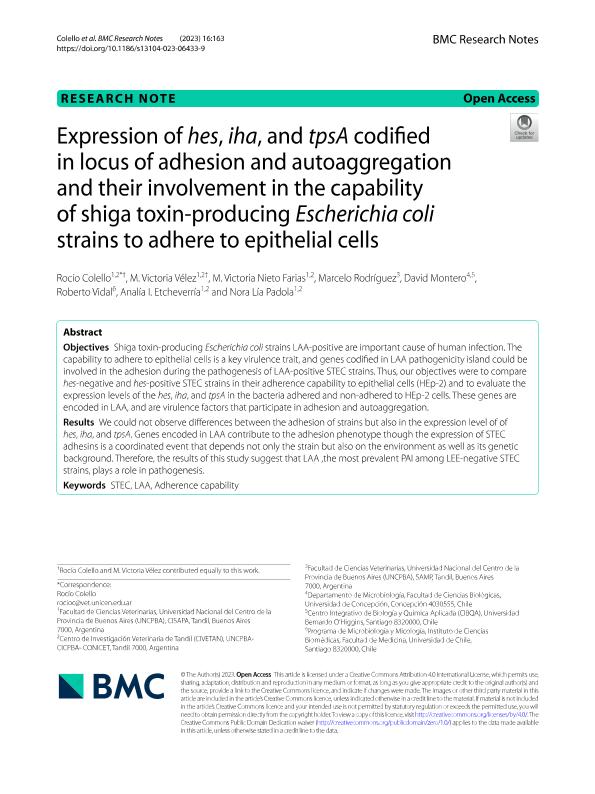Mostrar el registro sencillo del ítem
dc.contributor.author
Colello, Rocío

dc.contributor.author
Velez, Maria Victoria

dc.contributor.author
Nieto Farías, María Victoria

dc.contributor.author
Rodriguez, Marcelo
dc.contributor.author
Montero, David
dc.contributor.author
Vidal, Roberto
dc.contributor.author
Etcheverría, Analía Inés

dc.contributor.author
Padola, Nora Lía

dc.date.available
2023-11-21T13:54:11Z
dc.date.issued
2023-12
dc.identifier.citation
Colello, Rocío; Velez, Maria Victoria; Nieto Farías, María Victoria; Rodriguez, Marcelo; Montero, David; et al.; Expression of hes, iha, and tpsA codified in locus of adhesion and autoaggregation and their involvement in the capability of shiga toxin-producing Escherichia coli strains to adhere to epithelial cells; BioMed Central Ltd; BMC Research Notes; 16; 1; 12-2023; 1-7
dc.identifier.issn
1756-0500
dc.identifier.uri
http://hdl.handle.net/11336/218420
dc.description.abstract
Objectives: Shiga toxin-producing Escherichia coli strains LAA-positive are important cause of human infection. The capability to adhere to epithelial cells is a key virulence trait, and genes codified in LAA pathogenicity island could be involved in the adhesion during the pathogenesis of LAA-positive STEC strains. Thus, our objectives were to compare hes-negative and hes-positive STEC strains in their adherence capability to epithelial cells (HEp-2) and to evaluate the expression levels of the hes, iha, and tpsA in the bacteria adhered and non-adhered to HEp-2 cells. These genes are encoded in LAA, and are virulence factors that participate in adhesion and autoaggregation. Results: We could not observe differences between the adhesion of strains but also in the expression level of of hes, iha, and tpsA. Genes encoded in LAA contribute to the adhesion phenotype though the expression of STEC adhesins is a coordinated event that depends not only the strain but also on the environment as well as its genetic background. Therefore, the results of this study suggest that LAA ,the most prevalent PAI among LEE-negative STEC strains, plays a role in pathogenesis.
dc.format
application/pdf
dc.language.iso
eng
dc.publisher
BioMed Central Ltd
dc.rights
info:eu-repo/semantics/openAccess
dc.rights.uri
https://creativecommons.org/licenses/by-nc-sa/2.5/ar/
dc.subject
ADHERENCE CAPABILITY
dc.subject
LAA
dc.subject
STEC
dc.subject.classification
Biología Celular, Microbiología

dc.subject.classification
Ciencias Biológicas

dc.subject.classification
CIENCIAS NATURALES Y EXACTAS

dc.title
Expression of hes, iha, and tpsA codified in locus of adhesion and autoaggregation and their involvement in the capability of shiga toxin-producing Escherichia coli strains to adhere to epithelial cells
dc.type
info:eu-repo/semantics/article
dc.type
info:ar-repo/semantics/artículo
dc.type
info:eu-repo/semantics/publishedVersion
dc.date.updated
2023-11-16T18:13:07Z
dc.journal.volume
16
dc.journal.number
1
dc.journal.pagination
1-7
dc.journal.pais
Estados Unidos

dc.description.fil
Fil: Colello, Rocío. Consejo Nacional de Investigaciones Científicas y Técnicas. Centro Científico Tecnológico Conicet - Tandil. Centro de Investigación Veterinaria de Tandil. Universidad Nacional del Centro de la Provincia de Buenos Aires. Centro de Investigación Veterinaria de Tandil. Provincia de Buenos Aires. Gobernación. Comision de Investigaciones Científicas. Centro de Investigación Veterinaria de Tandil; Argentina
dc.description.fil
Fil: Velez, Maria Victoria. Consejo Nacional de Investigaciones Científicas y Técnicas. Centro Científico Tecnológico Conicet - Tandil. Centro de Investigación Veterinaria de Tandil. Universidad Nacional del Centro de la Provincia de Buenos Aires. Centro de Investigación Veterinaria de Tandil. Provincia de Buenos Aires. Gobernación. Comision de Investigaciones Científicas. Centro de Investigación Veterinaria de Tandil; Argentina
dc.description.fil
Fil: Nieto Farías, María Victoria. Consejo Nacional de Investigaciones Científicas y Técnicas. Centro Científico Tecnológico Conicet - Tandil. Centro de Investigación Veterinaria de Tandil. Universidad Nacional del Centro de la Provincia de Buenos Aires. Centro de Investigación Veterinaria de Tandil. Provincia de Buenos Aires. Gobernación. Comision de Investigaciones Científicas. Centro de Investigación Veterinaria de Tandil; Argentina
dc.description.fil
Fil: Rodriguez, Marcelo. Universidad Nacional del Centro de la Provincia de Buenos Aires. Facultad de Ciencias Veterinarias; Argentina
dc.description.fil
Fil: Montero, David. Universidad de Concepción; Chile
dc.description.fil
Fil: Vidal, Roberto. Universidad de Chile. Facultad de Medicina. Institutos de Ciencias Biomédicas; Chile
dc.description.fil
Fil: Etcheverría, Analía Inés. Consejo Nacional de Investigaciones Científicas y Técnicas. Centro Científico Tecnológico Conicet - Tandil. Centro de Investigación Veterinaria de Tandil. Universidad Nacional del Centro de la Provincia de Buenos Aires. Centro de Investigación Veterinaria de Tandil. Provincia de Buenos Aires. Gobernación. Comision de Investigaciones Científicas. Centro de Investigación Veterinaria de Tandil; Argentina
dc.description.fil
Fil: Padola, Nora Lía. Consejo Nacional de Investigaciones Científicas y Técnicas. Centro Científico Tecnológico Conicet - Tandil. Centro de Investigación Veterinaria de Tandil. Universidad Nacional del Centro de la Provincia de Buenos Aires. Centro de Investigación Veterinaria de Tandil. Provincia de Buenos Aires. Gobernación. Comision de Investigaciones Científicas. Centro de Investigación Veterinaria de Tandil; Argentina
dc.journal.title
BMC Research Notes
dc.relation.alternativeid
info:eu-repo/semantics/altIdentifier/url/https://bmcresnotes.biomedcentral.com/articles/10.1186/s13104-023-06433-9
dc.relation.alternativeid
info:eu-repo/semantics/altIdentifier/doi/http://dx.doi.org/10.1186/s13104-023-06433-9
Archivos asociados
